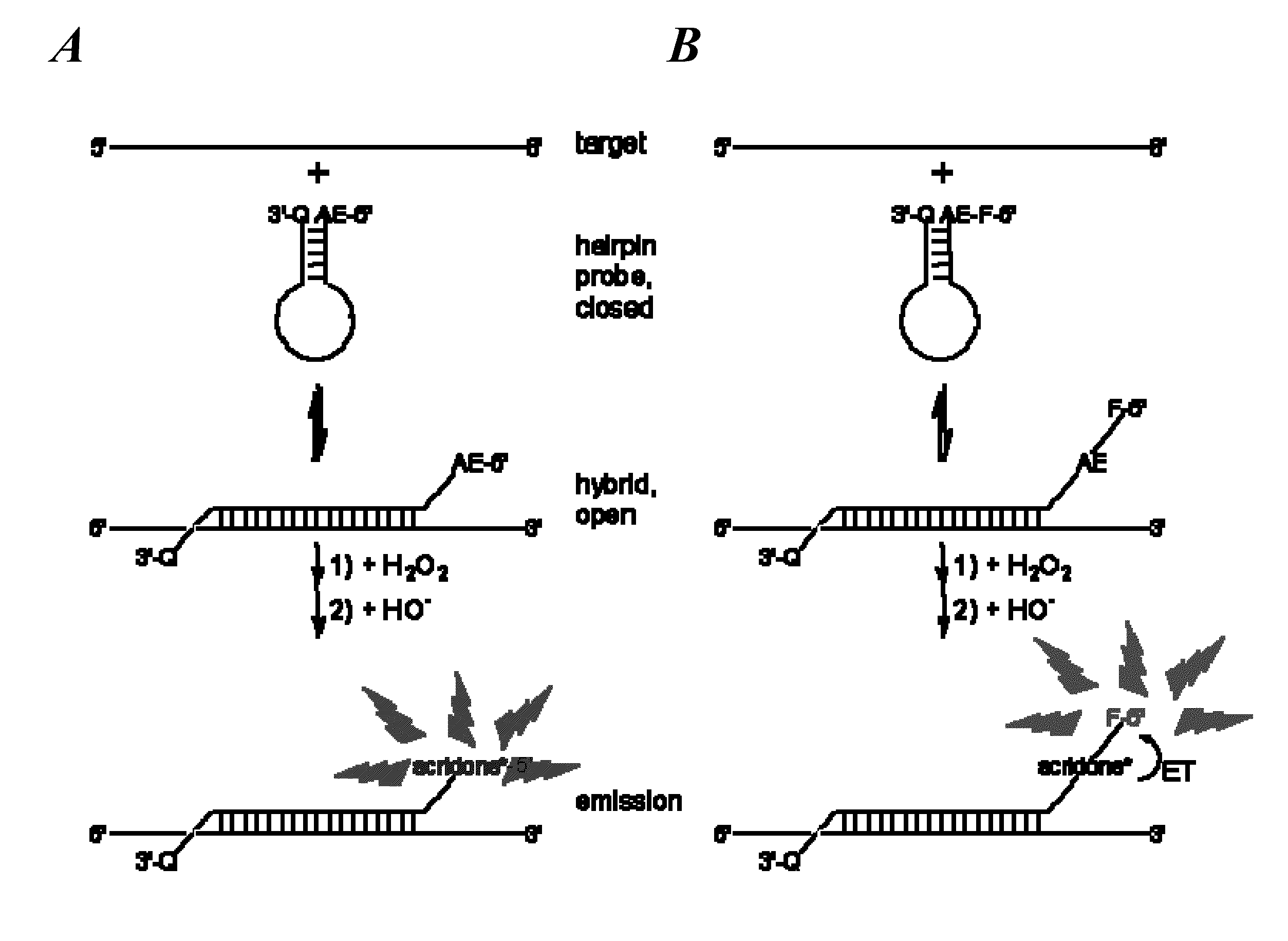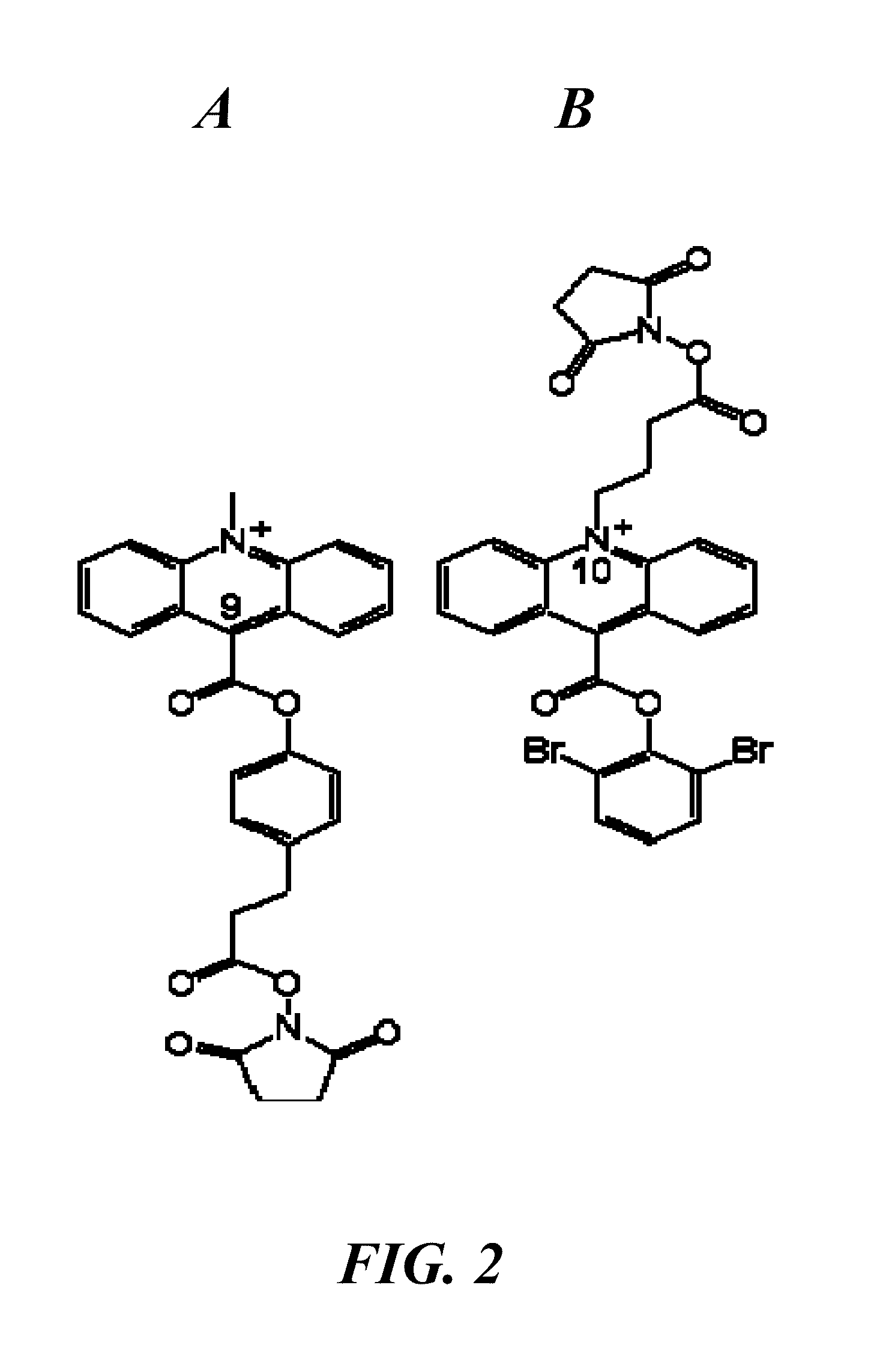Spectrally-resolved chemiluminescent probes for sensitive multiplex molecular quantification
a chemiluminescent probe and multiplex technology, applied in the field of molecular diagnostics, can solve the problems of reducing the throughput of design, synthesis and screening of large numbers of wavelength-distinguishable chemiluminescent probes, and involving a lot of effor
- Summary
- Abstract
- Description
- Claims
- Application Information
AI Technical Summary
Benefits of technology
Problems solved by technology
Method used
Image
Examples
example 1
Selection of Target and Probe Sequences
[0050]Five target sequences were selected (Table 1: SEQ ID NOs:1-5, 17, 18; Table 2) as representatives of two different, broad microbial groups found in environmental samples such as seawater (Enterococcus faecalis, Escherichia coli, and Candida albicans) (Hartz et al., J. Environ. Qual. 2008, 37:898-905; Papadakis et al., Water Res. 1997, 31:799-804) or of two pathogens that may occur individually or simultaneously in human urogenital swab or urine specimens (Chlamydia trachomatis and Neisseria gonorrhoeae) (Johnson et al., Clin. Chem. 2001, 47:760-63). In order to mimic more closely the natural nucleic acid materials, the synthetic target oligonucleotide sequences exceeded the length of the part for which complementary sequences in probes would be constructed (Table 1: SEQ ID NOs:6-10; Table 2: central part in each target sequence). These targets were synthesized on automated oligonucleotide synthesizers by established methods using phosphor...
example 2
Synthesis and Labeling of Oligonucleotides
[0053]Expedite model 8909 Nucleic Acid Synthesis Systems (PerSeptive Biosystems, now part of Life Technologies Corporation, Carlsbad, Calif.) were used to synthesize oligonucleotides on substituted 500 Å controlled pore glass (CPG) substrates packed in automated synthesizer columns. Deoxy CPG (Proligo, now part of Sigma-Aldrich, Boulder, Colo.) were used for DNA and RNA target syntheses, resulting in 3′-deoxyribonucleotides on these oligonucleotides. Probe sequences incorporating quencher units started with Black Hole Quencher-2 attached to a CPG via a glycolate linker and with a dimethoxytrityl (DMT) group protecting the terminal hydroxyl (p / n CG5-5042G, Biosearch Technologies, Inc., Novato, Calif.) or with a protected Dabcyl attached to a CPG (1-dimethoxytrityloxy-3[O-(N-4′-carboxy-4-(dimethylamino)-azobenzene)-3-aminopropyl)]-propyl-2-O-succinoyl-long chain alkylamino-CPG, p / n CPG1002N12DABXS, 3 Prime (a division of Prime Synthesis, Inc.,...
example 3
Performance of Wavelength-Shifted HICS Probes
3(a) Chemiluminescent Spectrographic Emissions
[0055]Spectrography was used to record time-resolved spectrograms of chemiluminescence and ET from AE to nearby fluorophores of a series of HICS and wsHICS probes with the same sequence but differing in fluorophore acceptor or its position. Time-resolved, spectrographic images of HICS probe chemiluminescent emissions were acquired on a low light, echelle-type SE200 spectrograph (Optomechanics Research Inc., Vail, Ariz.) using KestrelSpec software (Catalina Scientific Corp., Tucson, Ariz.). The images were transformed into spectrograms at 1 nm resolution and then processed with a locally weighted scatter plot smoothing (4%) algorithm (Cleveland, W. S. J. Am. Stat. Assoc. 1979, 74:829-36; Cleveland, W. S. & Devlin, S. J. J. Am. Stat. Assoc. 1988, 83:596-610) (LOESS utility Excel Add-In, Peltier Technical Services). 50-200 pmol / 100 μL of HICS or wsHICS probes, with or without equimolar amounts of...
PUM
| Property | Measurement | Unit |
|---|---|---|
| Electrical conductance | aaaaa | aaaaa |
| Electrical conductance | aaaaa | aaaaa |
| Electrical conductance | aaaaa | aaaaa |
Abstract
Description
Claims
Application Information
 Login to View More
Login to View More - R&D
- Intellectual Property
- Life Sciences
- Materials
- Tech Scout
- Unparalleled Data Quality
- Higher Quality Content
- 60% Fewer Hallucinations
Browse by: Latest US Patents, China's latest patents, Technical Efficacy Thesaurus, Application Domain, Technology Topic, Popular Technical Reports.
© 2025 PatSnap. All rights reserved.Legal|Privacy policy|Modern Slavery Act Transparency Statement|Sitemap|About US| Contact US: help@patsnap.com



